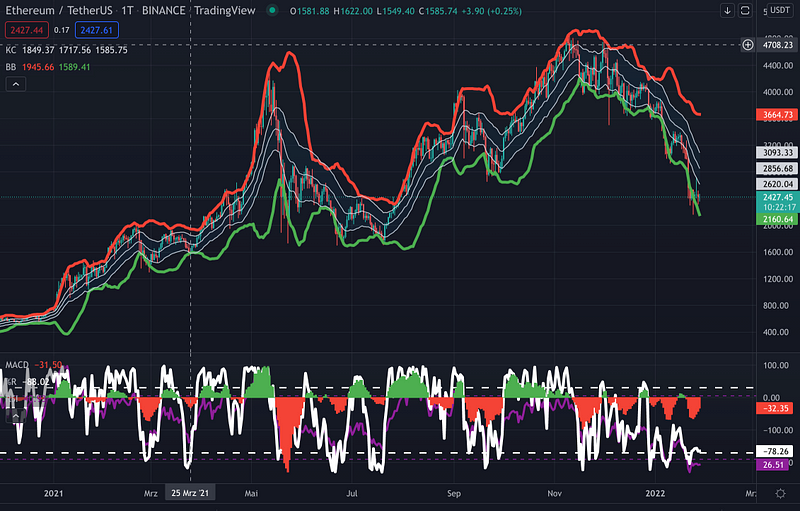Unraveling the Mystery: Why Ethereum Whales Are Buying ETH
Written on
Chapter 1: The Market's Turmoil
Recently, Ethereum experienced a significant downturn alongside the broader market, struggling to regain its former levels. This crash was marked by widespread sell-offs and liquidations, fueled by investor anxiety over a potential bear market, prompting many to exit before prices fell further. However, not all investors succumbed to the panic.
Whales, or large holders of cryptocurrency, have consistently exhibited unique behaviors compared to retail investors, and this situation was no exception. While many rushed to sell their assets at reduced prices, these whales seized the opportunity to accumulate ETH that was being offloaded onto the market, thereby consolidating their influence.
The first video, "It's Over For Ethereum. This Is Why Whales Are Selling. Act Fast," delves into the reasons behind the current market dynamics and the actions of major players.
Whales are accumulating Ethereum
In recent weeks, these large investors capitalized on the declining prices to purchase cryptocurrencies at what could be deemed bargain rates. Following a plunge to approximately $2,100, this provided whales with an excellent opportunity to expand their holdings.
Smaller investors eventually mimicked this strategy, but only after whales had already invested hundreds of millions into ETH. Notably, the number of addresses holding more than 10,000 ETH surged during this period, with whales collectively acquiring over $500 million in ETH within a few weeks.

This renewed interest from both whale investors and retail traders has helped to mitigate the decline in digital asset prices, but it hasn't been enough to trigger a significant recovery. Despite the growing support from large investors, the market sentiment remains one of fear, leading many to refrain from further investment.

Chapter 2: Ethereum's Struggles and the Future
The second video, "Crypto Whales are Accumulating This Altcoin WHY?" explores which altcoins are currently favored by whales and the implications for the market.
Ethereum's recent crash to a low of $2,100 has posed challenges for its recovery. Although it briefly rose above $2,400, it has struggled to gain any substantial upward momentum since then. Indicators suggest that Ethereum may continue to lack momentum in the near term, having recently tested the $2,700 mark before retreating to around $2,400.
For the first time in a year, Ethereum is trading below its 5-day, 20-day, 100-day, and 200-day moving averages. The prevailing market sentiment is bearish, and a continued downtrend could materialize as whale support wanes. Many investors are also looking forward to the anticipated Ethereum 2.0 upgrade.
What is Ethereum 2.0?
Since its inception in 2015, Ethereum has aimed to transition from its current proof-of-work consensus mechanism to a proof-of-stake (PoS) system. After years of research and delays, the launch of Ethereum 2.0 is now on the horizon.
The Ethereum network has been pushing against its transaction capacity limits, similar to Bitcoin, which also relies on the energy-intensive proof-of-work process. The upgrade to Ethereum 2.0 is designed to address these challenges.
Ethereum 2.0, often referred to as ETH2, will undergo a multi-phase transition starting from December 1, 2020, and is expected to take several years to complete. During this time, Ethereum 1.0 will continue to operate until all changes are finalized.
Ethereum 2.0 will introduce several enhancements, including:
- Proof-of-Stake consensus process: Transitioning from miners to validators who will earn newly minted ETH.
- Validators required to deposit a minimum of 32 ETH: A new economic model to secure the network.
- A parallel blockchain named Beacon Chain: To manage the PoS.
- Shards (side chains): To improve scalability, reducing the data storage burden on individual nodes.
Ethereum 2.0 explained: what are the benefits?
- Increased transaction capacity: Currently, Ethereum processes 15 to 45 transactions per second, while Ethereum 2.0 aims for up to 100,000.
- Lower transaction fees: Presently, Ethereum users face fees ranging from $10 to $100, but the new system should significantly reduce costs.
- Enhanced security: With the PoS model, validators who violate rules face penalties, improving network resilience.
- Reduced hardware requirements: The upgrade will lessen the need for high-end hardware, making it easier for individuals to run nodes and contribute to network security.
For further updates on Ethereum and potential trading signals, consider following Fat Pig Signals and joining their Telegram group!
JOIN THE FREE GROUP NOW!
5 Reasons Why You Should Use Fat Pig Signals Crypto Alerts
To succeed in cryptocurrency trading, understanding the market is crucial. Making informed trading decisions requires up-to-date insights and strategies.